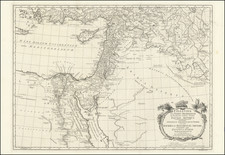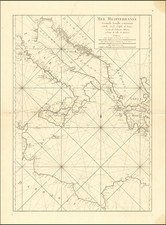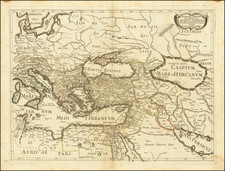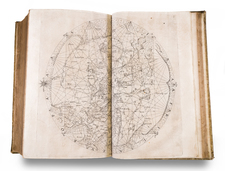Fascinating hydrographic map of the currents of the Mediterranean and Black Seas, from an early edition of Kircher's Mundus Subterraneus. This map appeared on page 152 of Book I, with "Derpano" on the coast of Sicily, later corrected to "Drepana", when the map appears on page 163.
Kircher was a proponent of the "reversed hydrologic cycle" and subterranean circulation. Oceans were thought to feed mountain springs by subterranean rivers, through which the water was desalinized and met through seabed whirlpools; precipitation was not considered a principal force. Similarly, the fiery core of the earth was thought to channel up through volcanoes. Kircher believed these systems as working in parallel to those of the human body for bodily heat and blood flow.
Athanasius Kircher (1601-1680) was a Jesuit priest and a well-respected scholar known for his role in disseminating knowledge. Kircher was educated in Greek, Hebrew, and the humanities at Fulda, Paderborn, Cologne, Koblenz, and Mainz. After fleeing the Thirty Years’ War in Germany, Kircher worked as an academic at Avignon and, from 1634, Rome.
In Rome, Kircher served as an intellectual node, spreading information sent from around the world by Jesuit missionaries. Particular interests included ancient Egypt, astronomy, mathematics, medicine, music, and languages (both ancient and modern). He also made several maps and was a geographic compiler. It is likely he was the first person to depict the Pacific Ring of Fire on a map.
Kircher combined a mixture of hermeticism with nascent scientific inquiry, gaining him a reputation as one of the final Renaissance men. For example, he observed the eruptions of Etna and Stromboli. He had himself lowered into the crater of Vesuvius soon after an eruption to observe the changes wrought by the cataclysm. He experimented with bioluminescence by seeking the applications of firefly extract as a light source. He also made the first known Aeolian harp.
Kircher wrote 44 books, while over 2,000 of his manuscripts and letters survive. He also assembled one of the first natural history collections, the Museo Kircheriano or the Kircherianum, which was broken up after his death and became the foundation of several institutional collections.









![De Gelegentheyt van't Paradys en't Landt Canaan mitsgaders d'eerst bewoonde Landen der Patriachen uyt de H. Schristure …[Shows Cyprus]](https://storage.googleapis.com/raremaps/img/small/82746.jpg)




![[Rare Complete Example with Game Pieces] Grand Circuit Des Capitales. Collection Concours Du Chocolat Menier](https://storage.googleapis.com/raremaps/img/small/70922rd.jpg)